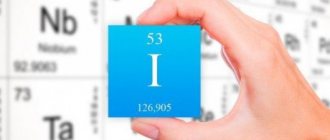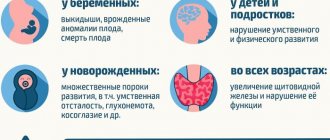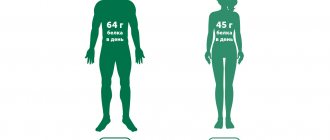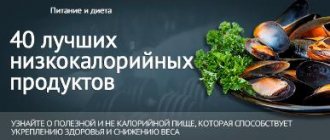Effect on the human body
The main biological role of iodine is the synthesis of thyroid hormones (triiodothyronine and thyroxine), which perform the following functions:
- stimulate the growth and development of the body, being responsible for the processes of tissue cell regeneration;
- regulate the exchange of vitamins, hormones and microelements;
- increase the production of new red blood cells in the bone marrow (erythropoiesis);
- activate the cardiovascular system (increase blood pressure, increase the frequency and strength of heart contractions, regulate vascular tone);
- potentiate oxygen consumption by tissues;
- control the transport of sodium and hormone-like substances through the cell membrane;
- increase the rate of biochemical reactions in the endocrine ring;
- regulate thermal, energy, water and electrolyte metabolism;
- enhance the oxidation of proteins, lipids and carbohydrates;
- potentiate the formation of phagocytes (blood cells that destroy harmful microorganisms);
- participate in the regulation of a person’s emotional tone (increase cognitive abilities, normalize mental activity);
- enhance the removal of excess fluid from the body;
- improve the functional state of the liver, brain, heart, blood vessels;
- regulate the processes of puberty;
- normalize the menstrual cycle;
- increase the activity of sex hormones, restoring a woman’s reproductive function (the ability to conceive and bear a fetus).
Due to its multifaceted effects on the human body, iodine is classified as a bio- and immunostimulating substance.
Daily norm
The daily need for iodine directly depends on a person’s age, physical condition and individual characteristics of the body. Considering that the microelement is not synthesized by the intestinal microflora, it must be regularly supplied with food or nutritional supplements.
The average daily norm for persons of different age categories is:
- for infants under 2 years old – 50 micrograms;
- for children from 2 to 6 years old – 90 micrograms;
- for children from 7 to 12 years old – 120 micrograms;
- for adults – 150 micrograms;
- for women during pregnancy and breastfeeding – 200 – 300 micrograms;
- for people working with compounds that depress the thyroid gland - 200 - 300 micrograms.
The exact daily dosage of iodine is calculated based on the calculation of 2 - 4 micrograms of the substance per kilogram of body weight.
The upper permissible level of mineral intake is 600 micrograms per day. Exceeding this indicator causes poisoning and intoxication of the body.
If the endocrine system malfunctions, before consuming the mineral, you should consult your doctor regarding the dosage.
How much iodine does a person need per day?
As we have already noted, a healthy person needs 100-200 mcg of iodine per day. However, this figure may change under the influence of a number of factors:
| A group of people | Daily iodine requirement, mcg |
| infants up to 12 months | 90-120 |
| preschool children | 120 |
| children 7-9 years old | 140-150 |
| children 10-12 years old | 180-200 |
| teenagers and adults up to 35 years old | 200 |
| adults over 36 years old | 180 |
| pregnant women | +30 mcg to normal for age |
| nursing women | +60 mcg to normal for age |
The human body is not able to synthesize iodine. We get it from food, water and air. Residents of Mediterranean countries practically never have a shortage of this microelement, since their diet is rich in fish and seafood. In addition, the coastal air itself contains a significant amount of iodine.
It is more difficult for residents of all other regions: according to statistics, almost two billion people on our planet have some degree of iodine deficiency. To cope with this problem, it is important to saturate your diet with seafood and fish. They allow the body to most effectively replenish iodine deficiency. As for vitamin complexes and food supplements with this microelement, they should be taken only as prescribed by your doctor.
Deficiency and excess
The concentration of iodine in the blood varies depending on the season: it decreases in the fall and increases in the spring. However, the thyroid gland absorbs exactly enough of the element to form thyroid hormones. At the same time, excess mineral is removed with urine and saliva.
Interestingly, over the past 20 years, the concentration of iodine in the soil has decreased threefold, as a result of which every third person on the planet has iodine deficiency, and every sixth person is at risk of developing hypothyroidism. A deficiency of the compound in the daily menu is a dangerous phenomenon, since prolonged deficiency provokes a “restructuring” of the function of the thyroid gland. This process is accompanied by an increase in the absorption of the element by the organ, as a result of which its excretion along with urine decreases. After this, adaptation processes are launched aimed at the most economical use of iodine. Such reactions underlie a decrease in thyroid function (hypothyroidism), which leads to a compensatory increase in the “butterfly” (endemic goiter). This condition is the optimal “springboard” for the development of severe thyroid pathologies, including nodules and cancer.
Symptoms of hypothyroidism:
- fatigue, weakness;
- weakening of memory, vision, hearing;
- decreased performance and concentration;
- apathy, drowsiness, mood swings;
- tearfulness;
- decreased blood pressure;
- slowing heart rate (up to 45-60 beats per minute);
- constipation, impaired motility of the digestive tract;
- sweating;
- weight gain;
- swelling;
- irritability;
- violation of thermoregulation, chills;
- menstrual disorders;
- dry skin and mucous membranes;
- hair loss;
- infertility, miscarriages, stillbirths.
The most severe consequences of iodine deficiency in newborns are cretinism, skeletal deformation, paralysis, and deaf-muteness. In view of this, women when planning pregnancy, carrying a fetus and breastfeeding need to carefully control the level of mineral intake in the body.
Causes of iodine deficiency:
- living in endemic regions where the soil and water are “depleted” of the mineral or there is an increased background radiation;
- insufficient consumption of iodine-containing foods;
- taking foods or medications that contain goitrogenic factors (thiourea, thiouracil, thiocyanate, derivatives of polyphenols, aniline and perchlorate) that interfere with the absorption and utilization of the microelement;
- use of drugs containing iodine antagonists (fluorine, manganese, cobalt, bromine, lead, chlorine);
- the presence of foci of chronic infections (tonsillitis, rhinosinusitis, pharyngitis, sinusitis);
- impaired absorption of the element due to a deficiency of zinc, copper, selenium, folic acid, vitamins C, and in the body.
To prevent and eliminate deficiency, the daily diet is enriched with iodine-containing products or complex dietary supplements. Interestingly, the microelement from seaweed is better absorbed than from medicinal analogues.
Remember, to relieve hypothyroidism, iodine preparations are taken with caution, only as prescribed by a doctor, since an overdose of the element is fraught with the development of iodism (aseptic inflammation of the mucous membranes in areas of mineral secretion), iododerma (toxic-allergic skin lesions), and hyperfunction of the thyroid gland.
Other signs of excess:
- tachycardia;
- increased salivation;
- headaches, fatigue;
- numbness and tingling of the skin;
- acne, skin rashes, including allergic ones;
- development of thyrotoxicosis;
- dyspeptic disorders, sometimes with blood;
- reduction in body weight and skeletal strength;
- goiter formation;
- nervousness;
- insomnia;
- lacrimation;
- paralysis, muscle weakness.
A single dose of iodine in excess of 500 milligrams can lead to direct poisoning. The first symptoms of intoxication are vomiting, brown skin discoloration, stool upset, severe abdominal pain, increased body temperature, and the appearance of a metallic taste in the mouth. If this condition is not stopped, death can occur due to irritation of nerve endings.
Contraindications for taking iodine supplements:
- increased thyroid function (hyperthyroidism);
- suspicion of thyroid cancer;
- Dühring's dermatitis;
- toxic goiter;
- radioactive iodine therapy;
- toxic thyroid adenoma;
- individual intolerance to the mineral.
Remember, increased iodine intake due to autoimmune diseases can aggravate hypothyroidism and reduce the pharmacological properties of thyroid medications.
Iodine deficiency: symptoms and consequences
The main symptoms of iodine deficiency include:
- frequent headaches;
- nervousness and irritability;
- high fatigue;
- depressed mood, apathy;
- memory and vision impairment;
- weakening of intelligence;
- poor skin condition;
- drowsiness and frequent headaches;
- deterioration of hair condition, baldness;
- the appearance of edema;
- tendency to frequent colds and infectious diseases;
- decreased sexual function in men;
- menstrual cycle disorders in women.
Even a slight lack of iodine in the human body can lead to serious chronic diseases of the endocrine, cardiovascular, genitourinary and other systems. Very often, with a lack of this microelement, hypothyroidism develops - a pathological decrease in the functions of the thyroid gland.
In children, iodine deficiency can cause slower mental, physical and sexual development. Pregnant women experience this condition even more painfully - they may have a miscarriage or develop various abnormalities in the development of the fetus. In addition, iodine deficiency often leads to metabolic disorders and, as a result, excess weight.
How to identify the body's need for this microelement? This is done quite simply: take a 5% iodine solution and draw a mesh on any part of the body. If after 6-8 hours the lines have completely disappeared, then your body needs this substance. If you turn pale but remain in place, you don’t have this problem. If you identify an iodine deficiency condition, be sure to enrich your diet with the products described in our material, and also consult your doctor to select the most suitable medications for complex treatment.
Natural sources of iodine
With a balanced diet, the daily need for iodine is met through foods of plant and animal origin.
In addition, some part of the element (up to 25% of the daily value), depending on the place of residence, enters the body with air and water. Table No. 1 “Natural sources of iodine”
| Product name | Iodine content in 100 grams of product, micrograms |
| Dried seaweed (kelp) | 2500 – 3000 |
| Cooked seaweed | 300 |
| Squid | 290 |
| Feijoa | 70 – 250 |
| Salmon, pollock | 200 |
| Hake, pollock, haddock | 150 – 160 |
| Blue whiting, cod, pinniped meat | 130 |
| Shrimp, oysters, crabs | 90 -100 |
| Perch | 65 |
| Rye bran | 60 |
| Pink salmon, perch, catfish, tuna, catfish, capelin, flounder, carp, salted herring, pike perch, pike | 50 |
| Mackerel, anchovies | 45 |
| Salted herring | 40 – 60 |
| Egg yolk | 35 |
| Champignon | 18 |
| Dairy and fermented milk products | 8 – 18 |
| Greens, legumes, vegetables | 6 – 15 |
| Cereals, fruits, berries | 2 – 10 |
In addition, good sources of the element are Himalayan salt, apple seeds, iodide and iodine-bromine mineral waters. In small concentrations (up to 10 micrograms per 100 grams of product), the mineral is present in all fermented milk products, garlic, feijoa, persimmons, radishes, eggplants, potatoes, spinach, sorrel, asparagus, grapes, strawberries, onions and green onions.
During culinary processing or long-term storage, the iodine content in products decreases significantly. Thus, when cooking fish, meat, cereals, legumes, 45–65% of the microelement is lost, when baking bread – 70–80%, when boiling milk – 20–25%, when boiling potatoes and other vegetables “in their jackets” – 30–40 %, and in crushed form - 45-50%.
Products containing iodine
Many people know that the highest iodine content is in seafood. This applies not only to fish, but also to other inhabitants of the deep sea, including algae.
In each food group you can find those that are rich in an element and correspond to our gastronomic preferences.
Let's look at the main ones.
Seafood containing iodine:
- shellfish (squid, octopus, mussels, oysters, scallops (not to be confused with coral mushroom));
- arthropods (shrimp, crabs, lobsters);
- fish (flounder, herring, mackerel, cod (including its liver), halibut, tuna, salmon, salmon, sea bass);
- algae (kelp, better known as seaweed, edible red algae - nori).
Vegetables and grains containing iodine:
- white cabbage, broccoli, cauliflower, spinach, asparagus, lettuce;
- nightshades (sweet peppers, tomatoes, eggplants, potatoes);
- carrots, beets, turnips, radishes;
- garlic, onion,
- cereals (buckwheat, oats, wheat, rye);
- legumes (peas, beans, peanuts);
- nuts (walnuts).
Berries and fruits containing iodine:
- feijoa;
- bananas;
- persimmon;
- strawberry;
- plum;
- cranberry;
- grape;
- chokeberry;
- lemon;
- orange;
- melon;
- a pineapple.
Animal products containing iodine:
- eggs;
- beef;
- milk;
- butter;
- cheese;
- sour cream;
- kefir.
Please note that the foods richest in iodine are those that are grown either in the sea or in areas where there is a sea nearby. River fish also contains this trace element, but in smaller quantities than sea fish.
It should be noted that this element is quite volatile. During heat treatment or long-term storage, it partially or completely evaporates. Therefore, vegetables and fruits containing iodine should be consumed fresh. Iodine-containing products for the thyroid gland that require mandatory heat treatment are best steamed or stewed for a short period of time. Boiling and frying will strip the food of a valuable component.
Increasingly, on the shelves of grocery stores we find ready-made iodine-containing products for the thyroid gland or semi-finished products artificially enriched with microelements: bread, baby food, etc. You can also add iodized salt to your diet. This salt has a limited shelf life, so it is better to use it immediately, for example, by salting a slice of tomato with it. Iodine can also be obtained by taking special supplements and medications: potassium iodide, fish oil. In organic form and from food, iodine is absorbed much better than from inorganic salts.
When including foods containing iodine in your diet, you must take into account that excess levels of the microelement can also cause a number of health problems. Therefore, in order to compensate for the lack of microelement content in your body, it is enough to simply diversify the menu and add sea fish, vegetables and fruits containing iodine to it daily. When following a diet, rely on the “rating” table of products containing iodine (Table 2) and the daily requirement for the microelement in accordance with age.
Table 2 – Iodine content in food products
| Product | Iodine content, mcg/100 g of product |
| Fish fat | 700 |
| Cod liver | 370 |
| Feijoa | 350 |
| Squid | 300 |
| Sea kale | 300 |
| Haddock | 245 |
| Freshwater fish | 240 |
| Salmon | 200 |
| Shrimps | 190 |
| Flounder | 190 |
| Pollock | 150 |
| Mackerel | 145 |
| Sea bass | 145 |
| Cod | 130 |
| Herring | 70-90 |
| Apples | 70 |
| Oysters | 60 |
| Feld salad | 65 |
| Tuna | 50 |
| Persimmon | 30 |
| Oats | 20 |
| Champignon | 18 |
| Egg yolk | 18 |
| Pork | 17 |
| Milk | 15 – 20 |
| Broccoli | 15 |
| Beans | 12 |
| Beef | 12 |
| Spinach | 12 |
| Peas | 11 |
| Cheese | 11 |
| Butter | 8 – 10 |
| Wheat bread | 9 |
| Soybeans | 8 |
| Radish | 8 |
| Grape | 8 |
| Beet | 7 |
| Carrot | 6 – 7 |
| Cabbage | 6 – 7 |
| Chicken | 6 |
| Potato | 5 – 6 |
| Chocolate | 5 – 6 |
| Onion | 5 |
| Buckwheat | 3 – 4 |
| Sorrel | 3 |
| Fruits | 2 – 6 |
However, there are dangerous iodine-containing products. For the thyroid gland, which is prone to overgrowth, products containing goitrogenic substances are undesirable. Among them are cauliflower, broccoli, radishes, turnips, radishes, spinach, beans, carrots, soybeans, and peanuts. The use of these products is not recommended for people suffering from endemic goiter and other pathologies associated with diffuse enlargement of the thyroid gland. They contain substances that block the synthesis of thyroid hormones, resulting in an increase in thyrotropin levels.











